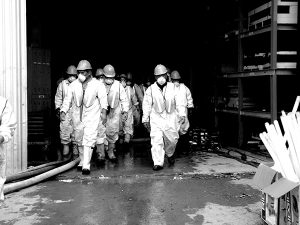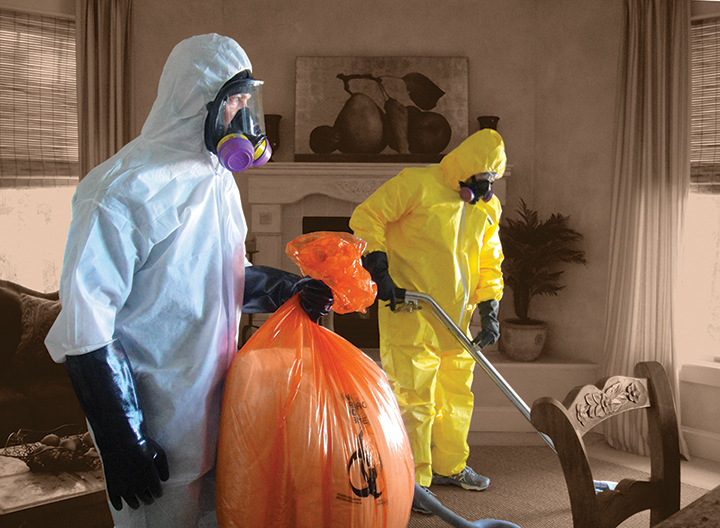Expert Biohazard Cleansing and Purification for Blood, Bodily Fluids, and Hazardous Materials
The potential health threats connected with direct exposure to biohazards emphasize the critical demand for thorough handling and detailed cleaning. As we browse the complex landscape of biohazard clean-up, comprehending the subtleties of guidelines, conformity, and the customized tools at play comes to be imperative in making certain a complete and secure decontamination procedure.
Wellness Dangers of Biohazard Direct Exposure
Direct exposure to biohazards presents considerable health risks that can lead to severe repercussions for communities and people alike. Biohazards encompass a variety of biological compounds, consisting of blood, bodily fluids, mold, microorganisms, viruses, and other potentially transmittable materials. When people enter contact with these biohazards, whether via accidents, inappropriate handling, or environmental direct exposure, they deal with the danger of contracting major ailments or conditions.
One of the primary wellness risks related to biohazard direct exposure is the transmission of contagious diseases. Bloodborne pathogens such as HIV, hepatitis B and C, and numerous germs can be present in biohazardous materials, posturing a straight danger to human wellness. Breathing in airborne biohazards like mold spores or coming into contact with polluted surface areas can additionally bring about respiratory system problems, allergic reactions, and various other unfavorable health effects.
Additionally, biohazard exposure can have long-term health and wellness implications, with some illness manifesting years after the preliminary contact (Blood Cleanup). Therefore, it is important to prioritize correct biohazard cleansing and purification to mitigate these wellness threats and make sure the safety and security of areas and people

Specialized Training for Biohazard Clean-up
When it involves handling biohazard cleaning effectively and safely, specialized training plays a fundamental role in guaranteeing proper decontamination treatments are followed. Biohazard cleanup calls for certain understanding and skills to effectively mitigate risks related to bloodborne microorganisms, physical liquids, and unsafe products. Professionals learnt biohazard cleanup go through rigorous direction on just how to safely manage, remove, and deal with biohazardous materials to avoid contamination and direct exposure.
Specialized training for biohazard cleaning covers a series of important subjects, including appropriate individual safety tools (PPE) usage, bloodborne pathogen awareness, decontamination methods, and dangerous waste disposal methods. Individuals learnt biohazard clean-up are equipped with the necessary competence to examine contamination degrees, identify possible threats, and apply proper clean-up procedures in conformity with regulatory requirements.
Continuous training and education and learning are critical in the field of biohazard cleaning to stay upgraded on the most recent decontamination modern technologies, safety methods, and regulations. By purchasing specialized training, biohazard cleaning specialists can properly react to emergency clean-up scenarios and guard both public health and the atmosphere.
Importance of Appropriate Purification Strategies
Utilizing correct decontamination strategies is critical in biohazard clean-up to effectively remove dangerous products and lessen health dangers. Effective purification view not only makes sure the removal of visible traces of blood, physical fluids, and various other biohazards but likewise targets invisible virus that may posture major wellness risks otherwise properly eliminated. By adhering to strict purification methods, trained professionals can dramatically lower the risk of direct exposure to unsafe microorganisms, viruses, and microorganisms that can result in illness or infections.
Appropriate purification techniques involve using customized tools and disinfectants that are specifically developed to reduce the effects of biohazards successfully. Thorough cleansing and disinfection of contaminated areas are necessary to protect against the spread of pathogens and make sure a secure environment for residents. In addition, the correct disposal of biohazardous waste complying with purification treatments is important in protecting against contamination of various other surfaces or people.

Devices and Devices for Safe Cleaning
When dealing with blood, bodily fluids, or hazardous materials, biohazard cleaning experts depend on specialized equipment to lessen direct exposure threats and thoroughly sanitize the damaged location. In addition, biohazard cleansing sets having disinfectants, absorptive materials, and biohazard bags are used to safely consist of and dispose of click to investigate infected products.
Advanced cleaning tools like hospital-grade anti-bacterials, HEPA-filtered vacuum cleaners, and fogging devices are used to sterilize surface areas and remove biohazards successfully. Specialized equipment such as sharps containers and biohazard garbage disposal containers are utilized to securely take care of sharp items and biohazardous waste materials. By utilizing the appropriate equipment and tools, biohazard cleansing professionals can make sure a thorough cleanup process that prioritizes security and reduces health and wellness risks for both workers and owners of the damaged area.
Regulations and Compliance in Biohazard Cleansing
Proper adherence to regulations and conformity criteria is paramount in biohazard cleansing to guarantee the safety of both workers and the environment. Federal government companies such as OSHA (Occupational Security and Health And Wellness Administration) and the EPA (Epa) have established particular standards for biohazard cleanup treatments to decrease health risks and ecological contamination. These regulations cover a variety of aspects including the handling, transportation, and disposal of biohazardous materials, in addition to the essential training and safety tools needed for workers involved in the cleaning procedure.
Biohazard cleaning business should stay up-to-date with these laws to ensure that their operations satisfy the needed security requirements. Failure to abide with these guidelines can result in severe repercussions, including fines, legal action, and jeopardizing the health and wellness of individuals and the setting. By complying with stringent guidelines and conformity steps, biohazard cleansing firms can properly reduce dangers and guarantee a comprehensive and secure cleaning process for all events involved.
Conclusion
Finally, biohazard cleansing and purification call for specialized training, proper methods, and adherence to laws. Exposure to blood, bodily liquids, and hazardous products poses substantial wellness threats, making it vital to use the appropriate tools and tools for safe cleaning. By complying with strict protocols and standards, specialists can effectively alleviate the dangers connected with biohazard direct exposure and make certain the security of both themselves and others.
As we browse the intricate landscape of biohazard cleaning, understanding the subtleties of regulations, conformity, and the specialized equipment at play ends up being critical in making sure a comprehensive and secure decontamination procedure. (Blood Cleanup)
When it comes to managing biohazard cleanup effectively crime scene cleanup hourly rate and safely, specialized training plays a fundamental duty in making sure appropriate decontamination procedures are followed.Making use of proper decontamination strategies is crucial in biohazard cleaning to effectively get rid of hazardous materials and lessen wellness dangers. Furthermore, biohazard cleaning sets consisting of anti-bacterials, absorptive products, and biohazard bags are used to securely dispose and consist of of polluted things.
Government companies such as OSHA (Occupational Safety And Security and Wellness Administration) and the EPA (Environmental Security Company) have actually developed specific standards for biohazard clean-up treatments to lessen health dangers and ecological contamination.